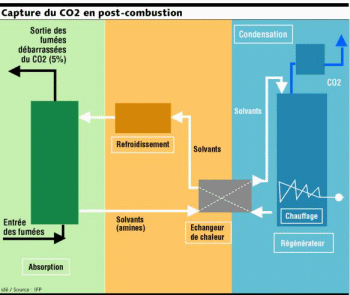The largest project in the world to capture carbon dioxide
Keywords: Beaver, CO2, sequestration, capture, capture, capture, decrease, optimization, clean plant, greenhouse effect, fight
More:
- Summary Document on CO2 Capture
- Castor Landfill Project on forums: debates, ideas, economic viability?
The largest carbon dioxide capture program in the world, the CASTOR project, set up with funds released by the EU under its Sixth Framework Program (FP6), was inaugurated on March 15 at the plant coal plant from Elsam, near Esbjerg (Denmark). This project is a large-scale trial to examine how to modify emissions from power plants to remove carbon dioxide, a greenhouse gas.
Elsam coal plant near Esbjerg (Credit Elsam)
Bringing together 30 partners from industry, research and academia from 11 European countries, the project aims to develop a model capable of reducing carbon dioxide emissions by 10%, which would represent 30% of total emissions from EU power plants.
The EU must drastically reduce its carbon dioxide emissions if it intends to meet the objectives initially set by the Kyoto Protocol, and which the Lisbon Agreement has come to strengthen. The Lisbon targets call for a 30-50% reduction in carbon dioxide emissions by 2020 compared to 1990 levels, with the decline expected to reach 60-80% by 2050.
“The European Commission is committed to a low carbon future. The research policy of today being the energy policy of tomorrow, projects such as CASTOR represent a very important contribution. Through the development of carbon capture and storage technologies, we can reduce emissions in the medium term, as we move to large-scale use of carbon-free renewable energies, ”said Janez Potocnik, EU Commissioner in charge. of science and research.
The CASTOR system is not just about diverting the waste gas into a bag. Carbon capture technology uses a solvent to separate carbon dioxide from gaseous emissions; carbon dioxide is incorporated into a calcium cycle to form calcium carbonate (limestone). The residual gases then pass through a special solid which allows the adsorption of the remaining CO2. The carbon dioxide is then released either in the form of limestone or in the form of carbon dioxide gas for geological burial.
Last year, the European Commissioner for Energy, Andris Piebalgs, put energy performance and carbon capture at the top of his agenda for the Seventh Research Framework Program. “Personally, I have no doubt for a second that, along with the increasing use of renewable energy, fossil fuels will remain the backbone of global energy production for the foreseeable future. Given the commitments made in Kyoto for the present and the future, the development of commercially viable technologies for capturing and storing CO2 must constitute a collective objective ”, he declared in April 2005 in a speech delivered at the Conference. European Commission on CO2 capture and storage.
Around 85% of Europe's energy needs are currently supplied by fossil fuels, which are the primary sources of carbon dioxide emissions. Other forms of energy are either too under-performing or under-advanced to meet most of our needs, although Sweden recently announced its intention to phase out fossil fuels from its economy.
The next generation of fossil-fueled power plants will use special “cracking” systems to separate the carbon from the fuel, leaving only hydrogen and solid carbon. Hydrogen can then be burned, as it is one of the few fuels with virtually no emissions and only produces water as a by-product.

The principle of the CASTOR program
The European Commission hopes that projects like CASTOR, coupled with programs focusing on hydrogen-based fuels and advances in renewable energy, will make a significant contribution to reducing carbon dioxide emission levels. The aim is to acquire "technology for a near-zero emission power plant" and the EU recently signed a memorandum of understanding with the Chinese government to further explore the possibilities of doing so.


